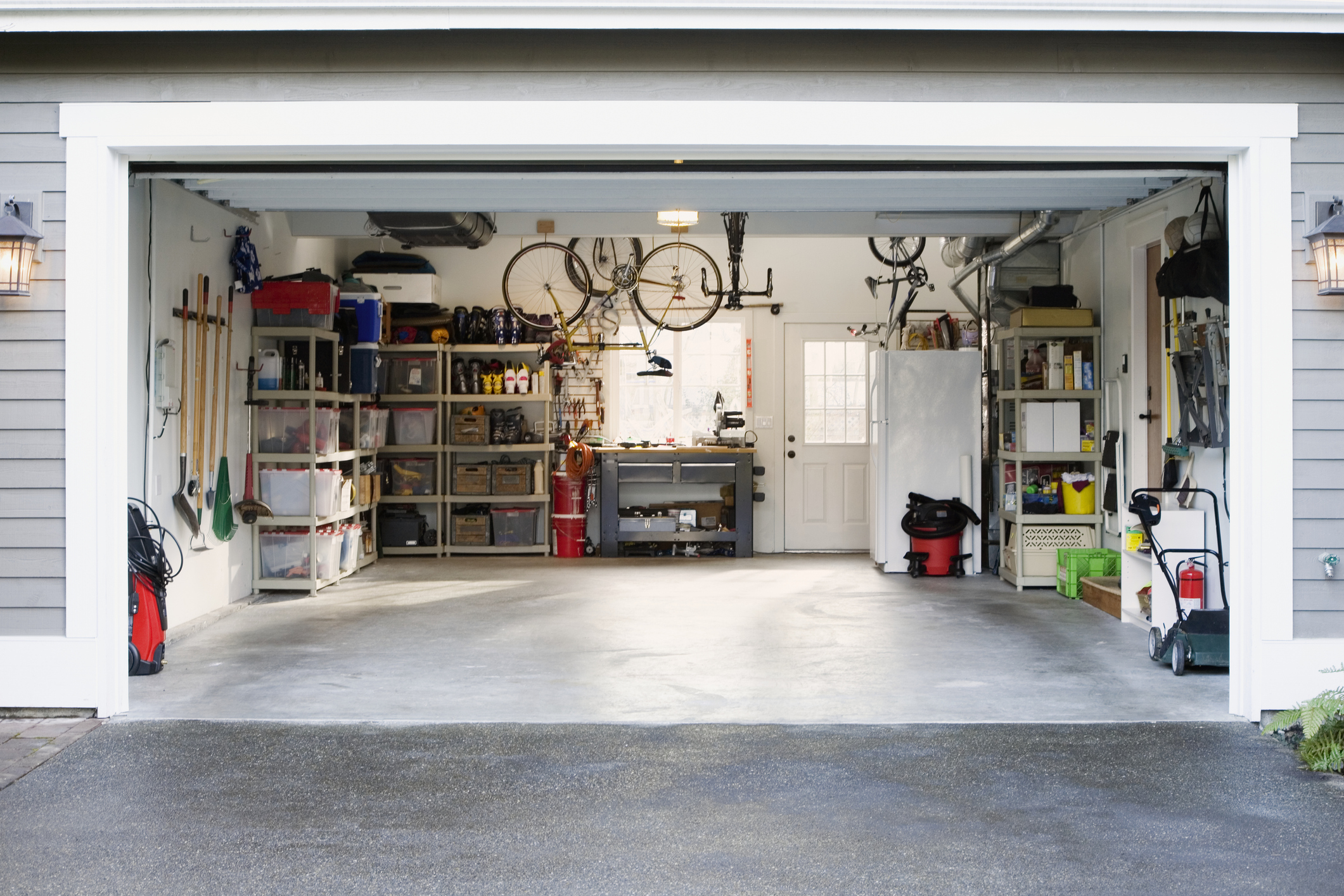What to consider before building a garage addition: Experts weigh in
From costs, to permits, to purpose, here's what you'll need to consider before you plan a garage addition, according to experts


For some people (myself included!), a garage is an essential part of the home. A garage provides convenience and safety, and keeps vehicles looking newer for much longer than if they were exposed to the elements. It can also provide extra storage and additional living space.
And there’s another advantage as well. “A garage has great ROI, so you’re likely to earn back 60-80 percent when it comes time to sell your home,” says Bailey Carson, home expert at Angi. But whether it’s plain, extravagant, or somewhere in-between, the garage needs to be functional.
If you’re thinking about building a garage addition, these are some factors to consider.
- Keep reading: 11 home addition ideas for budgets of all sizes
The cost of a garage addition
Your budget will most likely determine the type of garage you build. According to Carson, the cost can range from $6,000 to $60,000, and she says the national average is around $28,000. But those prices depend on a variety of factors.
Joe Landry, owner of Build Savvy in New Hampshire, says a lot of people assume a garage will cost around $30,000. But the “national average” cost of building a garage is like the national average for anything else – it could be much higher or much lower in your area – especially if you want all of the bells and whistles. “A basic garage can run from $65,000 and up, and if it has finished space above, it's in the mid-to-high $100,000’s.”
However, Elizabeth Dodson, co-founder of HomeZada, believes that the average person could probably get away with spending between $10,00 to $35,000. “But these costs could be higher now because of increased lumber prices,” she says. In addition, she notes it could take longer than usual to have the garage built due to a delay in materials, and the fact that many contractors are busy right now (in what we hope is the post-COVID-19 era).
Location and layout
An attached or a detached garage both offer pros and cons. “An attached garage is a great option if you’re on a smaller lot or simply want direct access to your home,” Carson says. And, it’s less expensive to build. “However, it is less secure than a detached garage, given its connection to your home, and can block light into your home that was coming in through any doors or windows on that wall,” she explains.
Get small space home decor ideas, celeb inspiration, DIY tips and more, straight to your inbox!
If you opt for a detached garage, Carson says it will be more expensive, but there are advantages to this choice. “It’s more secure, easier to expand, and more flexible in terms of layout, size and style,” she explains. But Landry warns that the reason it will be more expensive is because you’ll need more lumber, more labor, and more driveway work – so keep those factors in mind.
And here’s something else to consider: if the garage is attached, Landry says you can keep dry as you’re walking between your car and the house. And if the garage is visible to neighbors or people passing by, you’ll have more privacy as you’re loading or unloading your vehicle.
Another layout factor: “If you’re going to be walking back and forth a lot from the backyard to the garage, it makes sense to put a man door in the back,” Landry says. (A man door is a regular-sized door.) “People often want to add a man door towards the front end of the garage for foot traffic, but the idea is to not have to open the large overhead door every time,” he explains.
You’ll also need to choose from two layouts in relation to where the overhead doors are placed. “With a front load garage, the garage doors face the street, and you drive straight into the garage,” Landry explains.
With an end load garage, he says the garage doors are on the side of the garage. “This type of garage requires a lot more driveway work, and will need at least 25 feet beyond the side of the garage to allow for turnaround area.”
- Planning to use your garage for storage? Check out our top garage storage ideas.
Size of your garage addition
Size matters when you’re deciding on a garage addition. According to Dodson, the size and width of your lot are both important. “If you live on a narrow lot, you may only be able to build a specific size garage, for instance maybe a one-car garage versus a two- or four- car garage,” she says.
The size of your vehicle(s) will also play a role in the size of your garage. Oversized vehicles will require more space. “For oversized vehicles, we would definitely want to make the overhead doors and the overall footprint larger,” Landry says. While he notes that 9' x 7' doors are pretty standard, for someone with a large vehicle like a Suburban, he says a 9' x 8' door would work better.
“I like to figure 12' x 24' for each ‘bay’ of a new garage, so, for a 2-car garage, 24’ x 24’ is a pretty comfortable size, but it will get cramped for work benches, closets and stairways,” Landry explains.
Ray Dal Soglio is the chief construction officer at A Always Garage Doors in Scottsdale, AZ, and he agrees that what you plan on storing in your garage will play a role in how large it should be. “A person who owns an RV is going to need to build a much higher and much wider garage than someone looking to build a garage addition for their golf cart.”
- Keep reading: How to organize your garage this weekend in 5 easy steps
Columns, beams, and foundations
Another factor to consider is columns vs beams. Landry says that many people don’t like a lally column in the middle of the garage. “That’s because they've had to deal with them, and walk around them or bash their car door into them,” he explains. If you don’t want a column, he says you have other options. “To get rid of the column, either a beam needs to be installed, trussed roof, or ‘I joists’ if they're finishing the space above.”
The garage’s foundation is also important. “Foundations are normally 4' frost walls here in New England,” Landy says. But if you’re planning on a smaller garage (20’ x 20’ or under), he says a monolithic slab might work.
Storage
In addition to your vehicle(s), you’ll need to decide what else should be stored in your garage. “Depending on your garage storage needs, options range from cabinets, drawers, and workbenches to flat wall organizers and overhead storage,” Carson says. And she says you need to take storage space into account when determining both the size and layout.
Depending on the layout, Landry says the garage could end up being a closet or mud room. “The new garage is normally going to serve as the main entrance to the home, so having a place to kick off your shoes and hang your coats can be life changing,” he notes.
Dave Krzyzak is the owner of Palm Valley Garage Door in Goodyear, AZ. If you need extra storage space in your garage, he recommends installing a Jackshaft garage door opener. “These openers are installed on the side of your garage and not in the middle of your garage door ceiling,” he explains. “A jackshaft garage door opener allows you to utilize your garage's roofline, so you can install a storage nook or you could hang roof racks, and store bikes and anything else."
Living space
Another option is to use the garage for more than just storage. For example, Dodson says it could be used as additional room – for example, a home gym, office, or hobby room.
Carson agrees. “While you’re building a garage is a good time to consider whether you want to add additional living space to your home, and an Additional Dwelling Unit (ADU) is a great option for a home office, guest suite or rental property, but it does come with additional costs.”
According to Landry, you can create either finished or unfished space above the garage. “This means that there will need to be access to the space above, usually in the form of a stairway, which will need to be planned out, and it will usually require the garage to be oversized to accommodate it,” he says. “Having space above will almost always lead to talk of putting dormers on the front or maybe a full dormer along the back to take advantage of space.”
If it’s finished space and you want a bathroom and kitchenette, Carson says you’ll also need plumbing as well as the ability to heat and cool the area. “It’s a big investment, but it’s also a great way to expand add space and value to your home,” she says.
Electricity and HVAC
Even if you don’t want finished space above the garage, Carson says you may want to factor in electricity and HVAC needs for your garage. “If you’ll be spending a lot of time in there, you will likely want to look into options for heating and cooling the space, especially if you live in a place with distinct seasons,” she advises. “Also, make sure to equip the space with the necessary lighting, power, and outlets you need for any refrigerators, electric vehicle charging stations, or workstations.”
Insulation
Don’t forget about insulating the garage, regardless of how it will be used. “If you plan on spending a lot of time in your garage, you are going to want a really high insulation level to ensure you are not wasting tons of energy while your AC is running,” Dal Soglio advises. If you’re just parking the family car, he says you probably don’t need to purchase high-quality insulation. “If you are someone who is building a garage to store luxury cars, you do want good insulation in your garage to ensure the heat or cold won’t damage the interior and exterior."
Running water
Having running water in your garage can offer many benefits that you may not have even though of. “A garage is a great place for a dog wash, as long as you make it big enough,” Carson says. “This can also be really useful when your kids come home from a muddy soccer game, you get back from a camping trip, or even just when it comes time to clean your car or the garage itself.”
Lighting/security
Lighting is another consideration, and according to Landry, some homeowners want a lot of natural light in their garage. “You can add windows and have glass on the overhead and man doors to accomplish this,” he explains. On the other hand, Landry says some people don’t want any windows at all for security reasons.
Carson agrees and recommends thinking about how to keep the garage safe. “While windows and pet doors may seem like a great idea, they make it easier for burglars and rodents to find their way in,” she warns. And if you decide to get an attached garage, she recommends making sure the garage door to your home is as secure as your front door.
Permits and zoning
A garage is considered a new addition or new building. “This will likely require permits, so be sure to look into any restrictions or fees to make sure you’re in the clear,” Carson says. “As you’re going through the process, take a look at what your neighbors have, as that should help give you a good sense of what you’ll be able to do.”
You’re usually required to build the garage a certain distance from the street. Landry says most people don’t know the setback requirements for their city or town. “Normally, it's a simple phone call to the building department - and many towns now have websites that provide GIS (geographic information system) maps that show each parcel of land in town, information on the parcel, location of buildings, building setbacks, etc.,” he explains. “Having to get a variance if the setbacks aren't sufficient can add months to the project, and there aren't any promises that the Zoning Board of Appeals will grant the variance.”

Terri Williams is a journalist with real estate, home improvement, and product review bylines at Architectural Digest, Real Simple, Realtor.com, Bob Vila, Yahoo, MSN, The San Francisco Chronicle, The Houston Chronicle, and Apartment Therapy. She also covers business topics, with bylines at USA Today, The Economist, US New & World Report, Verizon, and several other brands that you’ve probably heard of. Follow her adventures on Twitter.